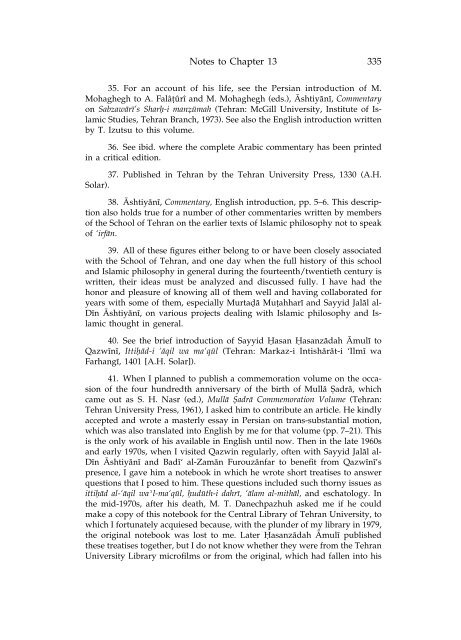Islamic Philosophy from Its Origin to the Present: Philosophy in the ...
Islamic Philosophy from Its Origin to the Present: Philosophy in the ...
Islamic Philosophy from Its Origin to the Present: Philosophy in the ...
You also want an ePaper? Increase the reach of your titles
YUMPU automatically turns print PDFs into web optimized ePapers that Google loves.
Notes <strong>to</strong> Chapter 13 335<br />
35. For an account of his life, see <strong>the</strong> Persian <strong>in</strong>troduction of M.<br />
Mohaghegh <strong>to</strong> A. Falâ†ûrî and M. Mohaghegh (eds.), ≈shtiyån¥, Commentary<br />
on Sabzawår¥’s Shar÷-i manz.¶mah (Tehran: McGill University, Institute of <strong>Islamic</strong><br />
Studies, Tehran Branch, 1973). See also <strong>the</strong> English <strong>in</strong>troduction written<br />
by T. Izutsu <strong>to</strong> this volume.<br />
36. See ibid. where <strong>the</strong> complete Arabic commentary has been pr<strong>in</strong>ted<br />
<strong>in</strong> a critical edition.<br />
37. Published <strong>in</strong> Tehran by <strong>the</strong> Tehran University Press, 1330 (A.H.<br />
Solar).<br />
38. ≈shtiyån¥, Commentary, English <strong>in</strong>troduction, pp. 5–6. This description<br />
also holds true for a number of o<strong>the</strong>r commentaries written by members<br />
of <strong>the</strong> School of Tehran on <strong>the</strong> earlier texts of <strong>Islamic</strong> philosophy not <strong>to</strong> speak<br />
of ‘irfån.<br />
39. All of <strong>the</strong>se figures ei<strong>the</strong>r belong <strong>to</strong> or have been closely associated<br />
with <strong>the</strong> School of Tehran, and one day when <strong>the</strong> full his<strong>to</strong>ry of this school<br />
and <strong>Islamic</strong> philosophy <strong>in</strong> general dur<strong>in</strong>g <strong>the</strong> fourteenth/twentieth century is<br />
written, <strong>the</strong>ir ideas must be analyzed and discussed fully. I have had <strong>the</strong><br />
honor and pleasure of know<strong>in</strong>g all of <strong>the</strong>m well and hav<strong>in</strong>g collaborated for<br />
years with some of <strong>the</strong>m, especially Murta∂å Mu†ahhar¥ and Sayyid Jalål al-<br />
D¥n ≈shtiyån¥, on various projects deal<strong>in</strong>g with <strong>Islamic</strong> philosophy and <strong>Islamic</strong><br />
thought <strong>in</strong> general.<br />
40. See <strong>the</strong> brief <strong>in</strong>troduction of Sayyid ¡asan ¡asanzådah ≈mul¥ <strong>to</strong><br />
Qazw¥n¥, Itti÷åd-i ‘åqil wa ma‘q¶l (Tehran: Markaz-i Intishåråt-i ‘Ilm¥ wa<br />
Farhang¥, 1401 [A.H. Solar]).<br />
41. When I planned <strong>to</strong> publish a commemoration volume on <strong>the</strong> occasion<br />
of <strong>the</strong> four hundredth anniversary of <strong>the</strong> birth of Mullå |adrå, which<br />
came out as S. H. Nasr (ed.), Mullå S. adrå Commemoration Volume (Tehran:<br />
Tehran University Press, 1961), I asked him <strong>to</strong> contribute an article. He k<strong>in</strong>dly<br />
accepted and wrote a masterly essay <strong>in</strong> Persian on trans-substantial motion,<br />
which was also translated <strong>in</strong><strong>to</strong> English by me for that volume (pp. 7–21). This<br />
is <strong>the</strong> only work of his available <strong>in</strong> English until now. Then <strong>in</strong> <strong>the</strong> late 1960s<br />
and early 1970s, when I visited Qazw<strong>in</strong> regularly, often with Sayyid Jalål al-<br />
D¥n ≈shtiyån¥ and Bad¥‘ al-Zamån Furouzånfar <strong>to</strong> benefit <strong>from</strong> Qazw¥n¥’s<br />
presence, I gave him a notebook <strong>in</strong> which he wrote short treatises <strong>to</strong> answer<br />
questions that I posed <strong>to</strong> him. These questions <strong>in</strong>cluded such thorny issues as<br />
itti÷åd al-‘åqil wa˘l-ma‘q¶l, ÷ud¶th-i dahr¥, ‘ålam al-mithål, and escha<strong>to</strong>logy. In<br />
<strong>the</strong> mid-1970s, after his death, M. T. Danechpazhuh asked me if he could<br />
make a copy of this notebook for <strong>the</strong> Central Library of Tehran University, <strong>to</strong><br />
which I fortunately acquiesed because, with <strong>the</strong> plunder of my library <strong>in</strong> 1979,<br />
<strong>the</strong> orig<strong>in</strong>al notebook was lost <strong>to</strong> me. Later ¡asanzådah ≈mul¥ published<br />
<strong>the</strong>se treatises <strong>to</strong>ge<strong>the</strong>r, but I do not know whe<strong>the</strong>r <strong>the</strong>y were <strong>from</strong> <strong>the</strong> Tehran<br />
University Library microfilms or <strong>from</strong> <strong>the</strong> orig<strong>in</strong>al, which had fallen <strong>in</strong><strong>to</strong> his

















